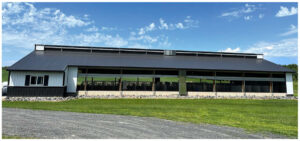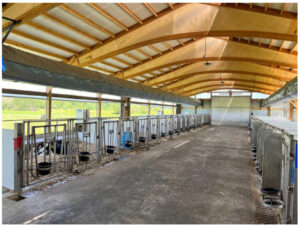An Interview: Bill Ciolkosz Discusses His Journey to Build a Quality Calf Barn
Click here to view as a pdf: An Interview Bill Ciolkosz Discusses His Journey to Build a Quality Calf Barn
In the fall of 2021, Bill Ciolkosz added a new calf barn to his operation, along with a Crystal Creek® FLAP DUCT® calf barn ventilation system. Bill is a fourth-generation farmer in Thorp, WI. The land he farms has been in his family for over a hundred years. In a recent interview with Crystal Creek®, Bill discussed the reasoning behind the features he chose for his new calf barn facility and how he decided the FLAP DUCT® ventilation system was the right choice for his calves.
Question: “What led you to consider building a calf barn over using outdoor hutches?”
Answer: “Having raised calves in outdoor hutches before, the calves did well initially, but once they were moved into group pens, their progress stalled. They went to a new barn with 10-12 calves per pen, and they just hit a wall. From two to three months old, they stood still. It took them about four or five months before they started looking good again. It was too much change at once. We needed to do something to ease that change.”
Weather was also a factor, with both the summer heat and the rain and snow during winter, being a concern. Ciolkosz kept the calves on 18 inches of sand, but still worried about keeping them cool. During the winter, extra bedding needed to be used to keep the calves dry from the rain and snow when in the outdoor hutches.
Question: “What were the most important features you wanted to include in the calf barn?”
Answer: “I toured different barns and went online and looked at about 25 barns. Talking with people who have had the barns for a while, you start to see what you like and what you don’t like. That gave me the idea to move the calves three feet away from the wall. Once we had that space, we could build a walkway to be able to bed from the back of the pen.”
While doing his research, Ciolkosz decided he wanted to give the calves the ability to socialize once they were a couple of weeks old. He looked into pens where the panels can be pulled and decided that his calves could benefit from being in groups of three or four at a few weeks of age. The calf barn he built allows calves to be in individual pens at birth and then have the panels pulled to allow group penning with socialization. While the calves are allowed to be in a group, they still have their own feeding pail to help keep conditions sanitary.
Ciolkosz also did research on the Crystal Creek® FLAP DUCT® ventilation system, talking to people who already installed the system and watching videos online. “The neatest thing was I gave a plan for the barn and Crystal Creek® custom made the tube for the barn. This isn’t a tube shoved in a barn where you then hope for the best, this is more: let’s make this thing work for you. It isn’t for everybody’s barn, it’s specifically made for my barn.”
Ciolkosz moved calves into the barn in October of 2021 and said “There has been very little stress on the calves, which makes weaning and transitioning easier. The FLAP DUCT® ventilation system is key. This past winter there was no draft, no pneumonia, which saved on treatment costs.” (For further information on input costs and the potential savings a FLAP DUCT® calf barn ventilation system can provide, see the article “The ROI of Calf Barn Ventilation” on page 6).
Question: “What advice would you give to someone considering building a calf barn?”
Answer: “Don’t be afraid to ask questions. Find the guys that will be honest with you. If you do enough research you can nail it down pretty close. Focus on the animal’s needs when building the barn. It’s not there for looks, it’s not there for building quality. It’s there for the animal. Do everything right for the animal. Build so that the animal is comfortable and can transition well. Build for your purpose.”
Another piece of advice Ciolkosz offered was to build with the next step in mind. Originally, he wanted to build for older animals and work his way down to the calf barn but decided it would be more beneficial to both the animal, and to his operation, to start with the calves. “We built everything to get to six months. Then to eight months, and eight months to a year. Start from the bottom and work your way up. Build in the sequence you need,” he said.
Question: “How did you deal with cost concerns regarding the calf barn?”
Answer: “Talking with other calf raisers and seeing how healthy their calves were. In our situation, what we were doing was not working. If I’m going to do something, I’m going to do it right or not at all. If you’re going to do it right sometimes it’s going to cost money.”
When asked what things he would definitely do again, Ciolkosz said there were a group of things that are key to the barn being successful like having 4×9 stalls, hay feeders, waterers, and the FLAP DUCT® calf barn ventilation system installed. Crystal Creek® would like to thank Bill Ciolkosz for taking the time to answer these questions and hope other calf raisers can benefit from this article. To learn more about the FLAP DUCT® system, call 1-888-376-6777 to speak to one of our knowledgeable ventilation specialists.



